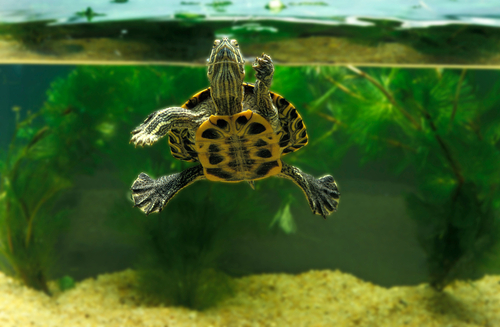Turtles can make fascinating and delightful pets, often becoming the stars of their aquatic world.
But if you’re thinking about introducing some finned or gilled friends to keep your shelled buddy company, you might wonder, “Who can safely share a tank with my turtle?” Fear not, as we’re here to unveil the 15 best turtle tank mates, ensuring harmonious cohabitation in your aquatic habitat.
From the sturdy Oscar fish to the swift Silver Dollars, selecting the right companions for your turtle involves understanding their shared environmental needs and behavior patterns.
We’ll dive into the essentials of turtle care and highlight a curated selection of companions that are compatible with your reptilian pal. Discover which tank mates make the cut and how to foster a thriving, peaceful tank ecosystem for everyone involved.
Let’s embark on this journey to enrich your turtle’s life and maybe, just maybe, make their aquarium a little more lively!
The best turtle tank mates include fish like Oscar fish and silver dollars. This is thanks to their similar needs in terms of warm water tank accommodations and nature that will not be bothered by the temperaments of the turtle.
Let’s get started.
Contents
Turtle Tank Mates – What You Need to Know
There are quite a few things it is most important to consider when matching the care of your turtle up with potential roommates in the tank! These are detailed below:
Temperament
Temperament refers to the general level of aggression or shyness in a tank dweller. Most turtles are carnivorous and happy to chase after and eat just about any fish they live with that they can get away with. This does not mean it is impossible to keep tank mates with your turtle, however.
All you need are fish that are semi-aggressive and alert enough in temperament enough to either defend themselves so the turtle learns not to bother them, or get away fast enough.
Size
The size of a tank mate with a turtle is highly important. If you have a red-eared slider turtle, for example, it can reach up to 12 inches in length. Tank mates, especially fish, that don’t want to wind up as turtle food need to be at least this length or larger when full grown for the best odds of survival in the same tank.
Competition
Competition generally refers to food competition. Your turtle may eat some of the same foods as its tank mates, which could lead to bullying, fighting, and starvation in one or more parties. Try selecting tank mates that are either fast enough to out-maneuver the turtle and still get fed, or eat at a different time of day.
Parameters ; Tank Setup
The most important thing to remember when setting up a tank with a turtle and other tank mates is that, if you have fish, they will need to be able to withstand high temperatures similar to the turtle. Additionally, as you’ll see in the list below, any tank mates to a turtle need to have at least 150 gallons in tank size for any chance at peaceful living!
15 Best Turtle Tank Mates
Let’s head into the main event: our list of the 15 best turtle tank mates!
- Bala Shark
- Oscars
- Silver Dollars
- Denison’s Barb
- Giant Danios
- Chinese Algae Eaters
- Kissing Gourami
- Sailfin Pleco
- Pumpkinseed Perch
- Peacock Bass
- Koi Fish
- Rainbow Shark
- Convict Cichlid
- Tiger Barb
- Blood Parrot Cichlid
Below, you’ll find a more in-depth look at turtle tank mates and their needs, hopefully helping you to decide which one works best not only for your turtle’s happiness, but your overall enjoyment of a community habitat!
Also see:
1. Bala Shark
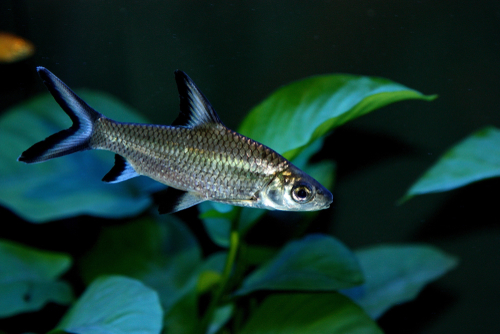
- Scientific Name: Balantiocheilos melanopterus
- Adult Size: 13 inches
- Compatible With: Red Eared Slider Turtles, Most Aquatic Turtles
- Care Level: Easy to Medium Difficulty
- Origin: Southeast Asia
This fish, sometimes called the silver bala or Malaysian shark, is not really part of the shark family at all. However, it is its size and finesse speeding through the water that will keep it alive as a tank mate for some turtles. The Bala shark starts out small, but can become as much as a foot long in size, making it difficult prey for a turtle it shares a tank with.
Pros of keeping with Turtle:
- Big enough to avoid turtle aggression.
- Can share food
Cons of keeping with Turtle :
- May compete for food
- Always a possibility of infighting.
2. Oscars
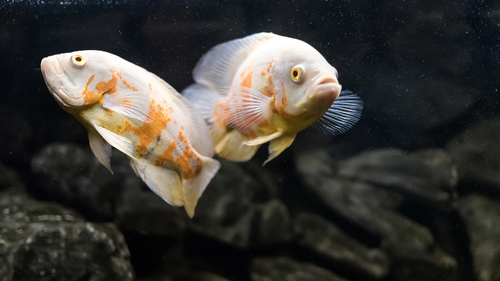
- Scientific Name: Astronotus ocellatus
- Adult Size: 12 to 18 inches
- Compatible With: Red Eared Slider Turtles, Most Aquatic Turtles
- Care Level: Easy
- Origin: South America
Oscars are varied in species, meaning they’ll offer a variety in terms of color to add to your turtle tank. However, the main reason to keep them as turtle tank mates is because they have almost identical personalities in terms of audacity and power to turtles.
Oscars have a reputation for yanking up plants and fighting with other fish, similarly to turtles. Often, they’ll teach any turtle that comes after them a lesson, if fully grown.
Pros of keeping with Turtle:
- Big and strong enough to avoid turtle aggression.
Cons of keeping with Turtle :
- Always a possibility of infighting.
3. Silver Dollars
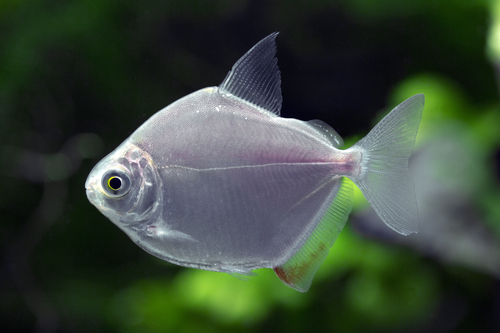
- Scientific Name: Metynnis argenteus
- Adult Size: 6 inches
- Compatible With: Red Eared Slider Turtles, Most Aquatic Turtles
- Care Level: Easy
- Origin: South America
If you’ve seen pictures of a silver dollar fish and notice that they look like flesh-stripping piranhas, you’re onto something: silver dollars are related to these carnivores. They are not quite as vicious or aggressive, preferring peace, but can move much more quickly in the water than a turtle.
This means that even the hungriest turtle won’t be likely to catch a silver dollar fish. They also happen to like to live in schools of 5, which can increase their feeling of safety and lower their stress even when living with hungry turtles.
Pros of keeping with Turtle:
- Fast enough to escape hungry turtles
Cons of keeping with Turtle :
- Always a possibility of infighting.
4. Denison’s Barb
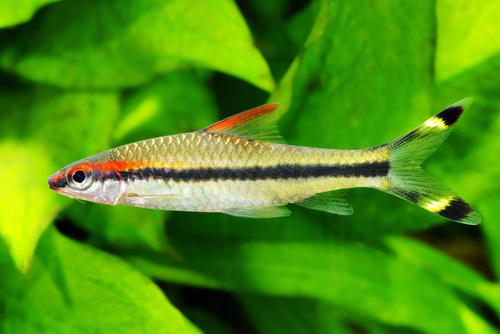
- Scientific Name: Puntius denisonii
- Adult Size: 6 inches
- Compatible With: Red Eared Slider Turtles, Most Aquatic Turtles
- Care Level: Easy
- Origin: India
This torpedo-like fish is aptly named for its shape, which gives it speed enough to escape bloodthirsty turtle tank mates. It is, however, on a red list as an endangered species, so it may not be the best first choice for a tank with a turtle just in case of accidents.
Pros of keeping with Turtle:
- Fast enough to avoid a hungry turtle
Cons of keeping with Turtle :
- Always a chance of infighting
- On the endangered species red list
5. Giant Danios

- Scientific Name: Devario Aequipinnatus
- Adult Size: 4 inches
- Compatible With: Red Eared Slider Turtles, Most Aquatic Turtles
- Care Level: Easy
- Origin: Nepal, Sri Lanka, India
You’ll never feel bored watching the big but nimble Giant Danios flitting around your turtle tank. They enjoy being kept with at least 5 of their own kind and have even been known to leap out of tanks if not watched carefully. Needless to say, a fish this agile can handle the dangers of living with a hungry reptile.
Pros of keeping with Turtle:
- Fast and large enough to avoid being eaten by a hungry turtle.
Cons of keeping with Turtle :
- Always a possibility of infighting
- Can jump out of unsealed tanks.
6. Chinese Algae Eaters
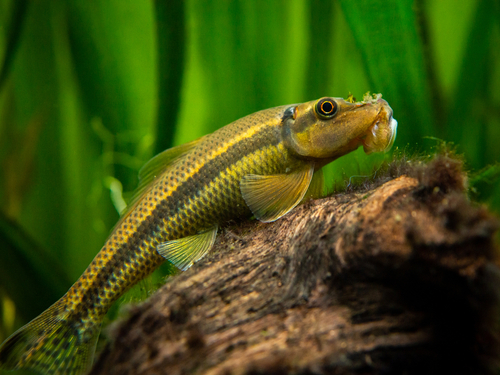
- Scientific Name: Gyrinocheilus aymonieri
- Adult Size: 6 to 10 inches
- Compatible With: Red Eared Slider Turtles, Most Aquatic Turtles
- Care Level: Easy
- Origin: China
The main appeal of a Chinese algae eater, which may at first look too mild-mannered to handle life with an aggressive turtle, is that they can contribute to cleaning up the turtle tank. This is awesome, since most turtles create plenty of mess and you may need all the fishy help you can get.
Additionally, Chinese algae eaters can reach 10 inches, which should be more than enough to avoid looking like food to your turtle. Not only that, but sometimes, when they get comfortable enough, a Chinese algae eater will clean your turtle’s shell of algae, too!
Pros of keeping with Turtle:
- Can clean up tank
- Can clean up turtle
- Large enough to avoid being eaten by a hungry turtle.
Cons of keeping with Turtle :
- Always a possibility of infighting!
7. Kissing Gourami
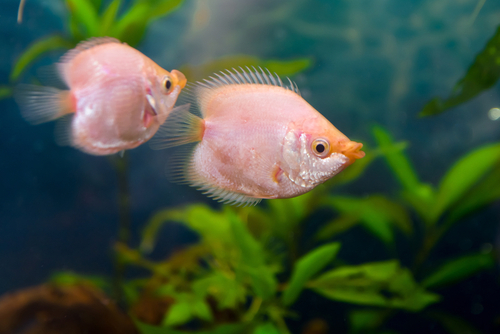
- Scientific Name: Helostoma temminckii
- Adult Size: 12 inches
- Compatible With: Red Eared Slider Turtles, Most Aquatic Turtles
- Care Level: Easy
- Origin: Indonesia
This lovely, colorfully ranged gourami is popular among aquarium collectors. What makes them suitable for life with a turtle is their size. They can become a foot long, so as long as a turtle is not larger than that, they aren’t likely to make the dinner menu!
Not only that, but the kissing-shaped lips that earned this species it’s name are good for eating excess algae, and their labyrinth organ makes them capable of handling lower oxygen in turtle-occupied waters more easily than other fish.
Pros of keeping with Turtle:
- Can handle lower oxygen levels
- Large enough to avoid being eaten by a hungry turtle
- Can clean up tank
Cons of keeping with Turtle :
- Always a possibility of infighting!
8. Sailfin Pleco
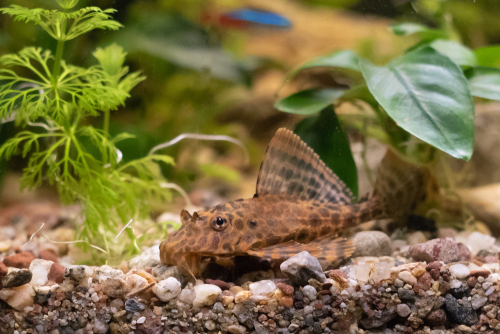
- Scientific Name: Pterygoplichthys Gibbiceps
- Adult Size: 9 to 19 inches
- Compatible With: Red Eared Slider Turtles, Most Aquatic Turtles
- Care Level: Easy
- Origin: South America
The Sailfin Pleco is another great fish to have on the “cleanup crew” of your turtle tank thanks to its tendency to eat algae. It can reach lengths perfectly suitable for avoiding the snack list of your turtle, but remember this means you’ll need a tank big enough to accommodate both animals.
Pros of keeping with Turtle:
- Can Clean Up tank
- Large enough to avoid being eaten by a hungry turtle
Cons of keeping with Turtle :
- Always a possibility of infighting!
9. Pumpkinseed Perch
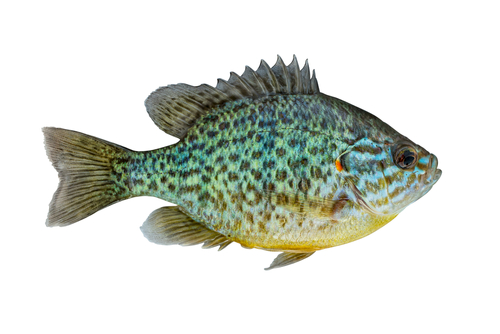
- Scientific Name: Lepomis gibbosus
- Adult Size: 10 to 15 inches
- Compatible With: Red Eared Slider Turtles, Most Aquatic Turtles
- Care Level: Medium difficulty
- Origin: Canada, North America
This beautiful-colored perch can be found in ponds, exceptionally large aquariums, or exceptionally large turtle tanks. It does eat worms and much of the same carnivore’s diet that a turtle does, but it will work as a tank or pond mate because of it’s size.
Pros of keeping with Turtle:
- Large enough to avoid being eaten by a hungry turtle.
Cons of keeping with Turtle :
- Should be kept in a pond or large tank.
- Always a possibility of infighting.
10. Peacock Bass

- Scientific Name: Cichla ocellaris
- Adult Size: 25 to 33 inches
- Compatible With: Red Eared Slider Turtles, Most Aquatic Turtles
- Care Level: Moderately difficult
- Origin: South America
This fish sure looks cool, but it definitely has aggression issues and will defend it’s territory from other fish. This might be a blessing when it comes to sharing space with an aggressive, carnivorous turtle, though. Remember that because of this fish’s large size, they should be given a large tank or even outdoor pond to share with a turtle.
Pros of keeping with Turtle:
- Large enough to avoid being eaten by a hungry turtle.
Cons of keeping with Turtle :
- Should be kept in a pond or large tank.
11. Koi Fish

- Scientific Name: Cyprinus rubrofuscus
- Adult Size: 24 to 36 inches
- Compatible With: Red Eared Slider Turtles, Most Aquatic Turtles
- Care Level: Easy
- Origin: Asia
Koi fish are beautiful, symbolic, and large! They are found all around the world as decorative pets and can coexist with a turtle, but remember that they grow more than two feet long so they need a huge aquarium or pond to share with a turtle.
Pros of keeping with Turtle:
- Too big to be considered turtle food.
Cons of keeping with Turtle :
- Should be kept in a pond or large tank.
12. Rainbow Shark
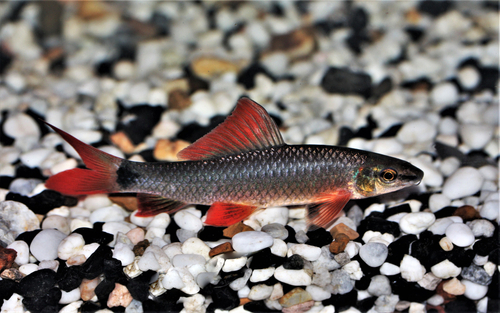
- Scientific Name: Epalzeorhynchos frenatum
- Adult Size: 6 inches
- Compatible With: Red Eared Slider Turtles, Most Aquatic Turtles
- Care Level: Easy
- Origin: Indochina
Rainbow sharks are very small. You may take a look at their red find and small dark bodies and think that they’ll look just like a snack to your turtle; and perhaps they will! However, a rainbow shark has two things going for it that will make it a good tank mate: it is a fast species, and an aggressive species.
If a turtle wants to make a meal of a rainbow shark, it’s in for an exhausting challenge. Typically, it will give up rather than cause trouble.
Pros of keeping with Turtle:
- Fast and aggressive enough to avoid being turtle food.
Cons of keeping with Turtle :
- Always a chance for infighting.
13. Convict Cichlid

- Scientific Name: Amatitlania nigrofasciata
- Adult Size: 4 to 5 inches
- Compatible With: Red Eared Slider Turtles, Most Aquatic Turtles
- Care Level: Easy
- Origin: Central America
The convict cichlid is one of the more aggressive of it’s already-temperamental species. It’s stripes are stylish, and it is both fast and tough enough to give a hungry turtle a run for it’s money!
Pros of keeping with Turtle:
- Too large and aggressive to wind up as turtle food.
Cons of keeping with Turtle :
- Always a chance for infighting.
14. Tiger Barb

- Scientific Name: Puntius Tetrazona
- Adult Size: 3 to 4 inches
- Compatible With: Red Eared Slider Turtles, Most Aquatic Turtles
- Care Level: Easy
- Origin: Malaysia, Borneo
The tiger barb may look both pink and small, but that does not mean it can’t hold it’s own against a turtle! Tiger barbs aren’t always the most aggressive fish, but they are fast enough to steer clear of hungry turtles.
Pros of keeping with Turtle:
- Fast enough to avoid being turtle food.
Cons of keeping with Turtle :
- Always a chance for infighting.
15. Blood Parrot Cichlid
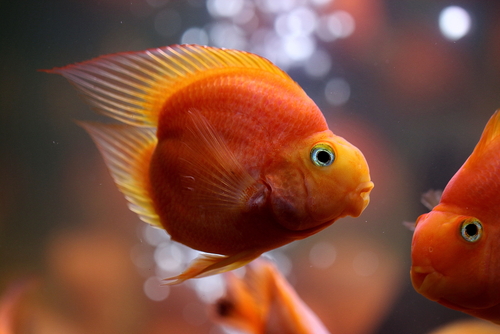
- Scientific Name: Amphilophus citrinellus x paraneetrophlus synspilus
- Adult Size: 8 inches
- Compatible With: Red Eared Slider Turtles, Most Aquatic Turtles
- Care Level: Easy
- Origin: Artificially created
Finally, one of the more popular cichlid species is the blood parrot cichlid, which is famous for its fiery temper matching its coloration. This will make it a formidable match for a turtle!
Pros of keeping with Turtle:
- Too aggressive to be likely to be eaten by a turtle.
Cons of keeping with Turtle :
- Always a chance for infighting.
In Conclusion
To sum everything we’ve covered up, no matter which turtle you are looking for the Best Turtle Tank Mates for, your candidates will need to be prepared for the hungry, destructive reptile they’ll be living with.
This limits your fish tank mate options to those that are the toughest in temperament, as well as able to survive in the same water parameters as aquatic fish. Some will be able to live in the same tank by bullying the turtle back or being more nimble, while others will need to live semi-separately in a pond, like Koi fish and pumpkinseed perch.
Regardless of which of the above fish you choose, as long as you keep temperament, size, food competition, and tank parameters in mind, you’ll never have a dull moment between your turtles and its tank mates!
FAQ: Creating a Harmonious Turtle Tank
1. How do I ensure the new tank mates will get along with my turtle?
To increase the chances of harmony in your turtle tank, start by choosing tank mates that match your turtle’s size and temperament. Look for fish or other creatures that thrive in similar water conditions and have a comparable diet, reducing competition for food.
It’s also wise to introduce new tank mates gradually and monitor their interactions closely, making adjustments as needed to prevent any bullying or aggression. Providing ample space, hiding spots, and visual barriers in the tank can help maintain peace and give each inhabitant their own territory.
2. Can my turtle get stressed with too many tank mates?
Yes, turtles can become stressed if their environment is too crowded or if their tank mates are too aggressive. Signs of stress in turtles include decreased appetite, lethargy, and increased hiding.
To minimize stress, ensure your tank is sufficiently large to accommodate everyone comfortably, typically at least 150 gallons for adult turtles and their friends. Regularly assess your turtle’s behavior and health, making any necessary changes to the tank community to keep the peace.
3. What should I do if one of the tank mates becomes aggressive?
If you notice aggression from any tank mate towards others, including the turtle, it’s important to act quickly to prevent injury. Initially, you might try rearranging the tank’s layout to disrupt established territories and add more hiding places.
If aggression persists, consider removing the aggressive individual and placing them in a separate tank.
Remember, the safety and well-being of all your aquatic pets are paramount, so keeping a close eye on their interactions and being prepared to intervene is key to maintaining a healthy, happy tank environment.

Ian Sterling, founder of Fishlab.com, began his aquarium journey over 30 years ago, driven by a deep fascination for fish and their diverse personalities. His website, Fishlab.com, is dedicated to making fishkeeping accessible and enjoyable, offering beginner-friendly guidance, expert insights, and a community for aquarists to connect and share experiences.


